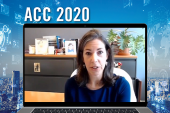Vasospasm Linked to Higher Atherosclerotic Risk in Patients With ANOCA
“These patients probably could be treated with disease-modifying medication,” the study author says.

In patients with angina and no obstructive coronary artery disease (ANOCA), coronary vasospasm elicited by acetylcholine, regardless of phenotype, is associated with more-advanced atherosclerosis, plaque vulnerability, and neovascularization on optical coherence tomography (OCT), according to new data.
Other studies have previously shown an association with spasm—which can affect both the epicardial vessels or the microcirculation—and greater plaque burden, “but seeing this higher incidence of plaque vulnerability markers probably makes [these patients] at risk for a higher event rate than we currently think,” senior author Peter Damman, MD, PhD (Radboud University Medical Center, Nijmegen, the Netherlands), told TCTMD.
Current treatment for patients presenting with ANOCA is “aimed at the anginal complaints,” with some being offered statins but most receiving calcium channel blockers and nitrates, he explained. However, the study “hints that these patients probably could be treated with disease-modifying medication,” although larger studies should be conducted to confirm this.
Notably, Damman explained, the population looked at in this study were termed to have ANOCA, as opposed to the oft-used moniker INOCA where the “I” stands for ischemia, “because most of the people present with complaints and not with an abnormal ischemia test, for example. But it should be the same population. Some people say INOCA is a more-stringent definition because you have proven ischemia, but for the discussion, it doesn't really matter.”
Tom Ford, MBChB (Hons), PhD (Central Heart, Gosford, Australia), who was not involved in the research, said that the clinical implications of these findings should translate into a greater emphasis on “treatment to reduce future MACE in addition to symptomatic treatment to alleviate ischemia,” he told TCTMD in an email. “Therapies including ACE-inhibitors/statins should be considered for these angina patients. The rationale is that standard ischemic heart disease ‘disease modifying’ atherosclerotic treatment in vasospasm patients may reduce likelihood of future vascular events.” The ongoing WARRIOR study is looking at just that, he added.
Not Necessarily ‘Benign’
For the study, published online this week in EuroIntervention, Dario Pellegrini, MD (Radboud University Medical Center), and colleagues enrolled 75 patients (93% women; mean age 55 years) with ANOCA and suspected coronary vasomotor dysfunction, referred for OCT imaging and a coronary function test (CFT)—comprised of an acetylcholine challenge and a physiology assessment with hyperemic indexes using adenosine—between February 2019 and January 2020.
Those who had coronary vasospasm triggered by acetylcholine (n = 59) had a higher lipid index (819.85 vs 269.95; P = 0.03) as well as an increased prevalence of vulnerable plaques (66% vs 38%; P = 0.04) compared with those who did not have spasm. Additionally, neovascularization was more likely in patients with vasospasm (37% vs 6%; P = 0.02), and there was a trend towards a higher prevalence of all individual markers, especially thin-cap fibroatheroma (20% vs 0; P = 0.06).
There were no differences in findings when coronary vasospasm was analyzed by phenotype.
“There is still widespread belief that coronary vasomotor dysfunction is a relatively benign condition, and this evaluation bias (ie, the false belief that, if there is no angiographic stenosis, there is no significant atherosclerosis) may also lead to an underestimation of future events and, therefore, to a decreased level of awareness and insufficient clinical monitoring over time,” the authors write. “The addition of anatomic information might provide additional prognostic value, which would in turn set the goal of treatment on harder outcomes, beyond simple symptom control.”
Effect on Treatment
Ford said he was surprised to see a similar atherosclerotic burden in patients with microvascular spasm and those with epicardial spasm because “the former is typically considered a form of coronary microvascular dysfunction.” Additionally, it was unexpected that about one-third of the vasospasm patients had no demonstrable atherosclerosis.
The next step will be for randomized trials to evaluate the relative efficacy of empirical antianginal agents, especially calcium antagonists and beta-blockers, in patients with microvascular spasm, Ford said. “Microvascular spasm may be driven by endothelial impairment and hence more reversible than established structural microvascular disorders. Targeted nonpharmacological therapy, including weight loss, education, and structured exercise programs warrant further study.”
There is a need for imaging research in this space, as well. Cardiac CT is often used to evaluate chest pain, though it has reduced spatial resolution in diagnosing atherosclerosis compared with intracoronary imaging, Ford explained. “Hence, it is unknown whether patients with a normal cardiac CT may have overlooked VSA,” he said, adding that the ongoing CorCTCA trial should help shed light on this.
Damman said one big unanswered question is how often these markers lead to MI. “We need a couple of these large cohorts showing that these patients in the longer term after that first prognosis have more myocardial infarctions,” he said. “And then of those myocardial infarctions, you want to know whether there are signs of atherosclerotic plaque rupture or erosions . . . or that it's an MI because of severe vasoconstrictive response. If you show the first part, if you see atherosclerotic ischemic events occurring, then you have a really strong indication to treat with a higher-intensity statin or maybe even aspirin.”
Yael L. Maxwell is Senior Medical Journalist for TCTMD and Section Editor of TCTMD's Fellows Forum. She served as the inaugural…
Read Full BioSources
Pellegrini D, Konst R, van Oord S, et al. Features of atherosclerosis in patients with angina and no obstructive coronary artery disease. EuroIntervention. 2022;Epub ahead of print.
Disclosures
- Damman reports receiving consultancy and lecture fees from Philips and Abbott.
- Pellegrini reports no relevant conflicts of interest.
- Ford reports receiving honoraria/speaker fees from Abbott Vascular, Boston Scientific, Boehringer Ingelheim, Biotronik, Bio-Excel, and Novartis.





Comments